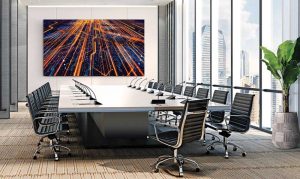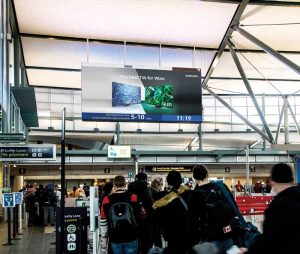Further, while there are many benefits to direct-view LED digital displays, it is also important to note the different types of technologies and product offerings, as well as their practical applications. In a corporate setting, bold feature walls could attract new office tenants and make existing ones want to stay, and seamless display walls are even replacing the classic projector displays in executive boardrooms. In retail, there is high demand for flagship stores to install direct-view LED displays outside to entice consumers to enter. They can also dial up the excitement by flanking entryways or creating whole facades that do away with more traditional store signage. Lastly, in transportation, auto manufacturers can create micro and satellite showrooms in unexpected locations, such as in shopping malls, on busy retail streets, or at the airport—removing any dependency on available inventory.
Indoor LED
Due to advances in digital display technology, LED is starting to replace LCD for video walls and other applications inside different venues. This is because the display cabinets are smaller and quieter, the displays manage power better (leading to lower operational costs), and serviceability and management are much easier than in past generations. Moreover, LED boasts a longer lifespan than LCD video wall screens, operating for years without significant degradation in performance or image quality. However, the real difference maker is how light chips are made and packaged for direct-view LED displays.

These new displays feature tightly spaced pixels, and are better suited for viewing up close, such as in a boardroom or lobby.
The most common LED technology used in indoor settings today is called surface mount diode (SMD) or package (PKG). It comprises red, green, and blue diodes packaged together in increasingly smaller dimensions, which has made it possible to pack light pixels closer together. Both indoor and outdoor LED products have a base rating of their pixel pitch, which is the measure of distance in millimetres between the centre of each LED package. Light pixels that are packed closer together, or have a fine pixel pitch, result in LED displays that look incredible from just a short distance away.
With enhanced picture quality and brightness, glare-free viewing, flexible configurations, and no visual seams, direct-view LED is ushering in a new era of digital display possibilities.
It is also important to understand the difference in price between LED displays is determined by the distance between pixels. Those that are more spaced out are more cost-efficient, and are best viewed from a greater distance, such as a storefront within a mall. Alternatively, displays with tightly spaced pixels are more costly and are better suited for viewing up close, such as in a boardroom or lobby. Fine-pitch LED displays have been adopted in a wide variety of other indoor settings, including in the concourses of sports arenas, airports, and conference centres. They are also being used as feature walls in skyscraper lobbies, big screens in sports bars, and marketing and promotional displays in flagship retailers.
Since costs have lowered and industry awareness has grown, LED has evolved from a specialty application to a popular option for any business owner or operator who wants to make a visual statement.






